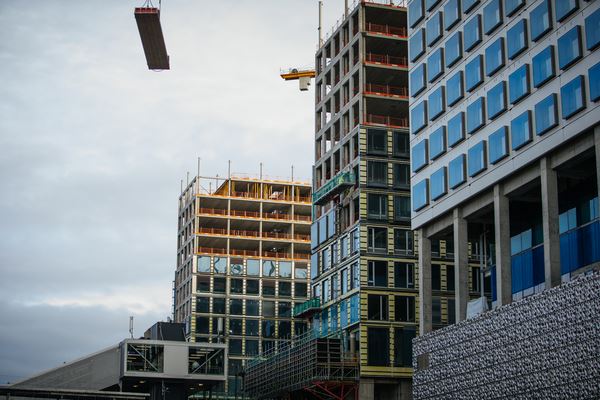Sustainable data centers as a service
- Work
- Construction
- Home
- 12/18/2019
The digital path leads the construction industry towards structural transformation
During the past decade, Building Information Modelling (BIM) has promoted the digital transformation of the entire construction industry, from design to implementation and site logistics. To achieve a genuine leap forward in productivity and quality, however, you need cooperation throughout the chain as well as batch production and prefabrication.

“This is such a cool gadget,” says Janne Salin, Head of Virtual Design and Construction (VDC) development at YIT, as he tries on his brand-new VR headset.
“I can use these to view and examine an object simultaneously with a designer colleague located in the United States, for example. We can see each other in the virtual environment and communicate via the VR headset’s built-in microphone and speakers,” he explains.
The sight of Salin wearing a virtual headset no longer surprises his colleagues, as he also used them at the Tripla construction site in Pasila to see a finished view of the massive lobby of the shopping centre, for example, when only the frame had been built.
“For some reason, the others haven’t been super excited by this VR headset,” Salin says.
Tripla as the prelude to digital construction
The construction of the massive shopping centre complex in Pasila was watched closely by local and national media from the day the foundation stone was laid until the grand opening. The project also received widespread attention within the industry, as it is one of the largest projects planned and implemented with the help of Building Information Modelling in Finland.
The new landmark in Pasila was also acknowledged by industry professionals when it won the 2019 Tekla Award in recognition of the successful use of BIM. The criteria for the award included the diverse and extensive use of Building Information Modelling in planning and design as well as in on-site operations, cooperation between various project parties based on BIM and the use of BIM in the production of construction components.
Salin says Tripla could have been built using more traditional methods, but it would have taken much longer. The impact on schedules would have been the most dramatic in planning and design work, but it is likely that many problems would also have been met at the construction site when the solutions created at the design table do not quite work in practical conditions.
“In addition to planning and design, BIM was used in managing the logistics of the entire construction site, which was another unique feature of the project,” Salin points out.
Digital twin solutions would be a big help
The Head of VDC envisions a world where Finnish builders can do even more. The next leap in performance, however, calls for new operating methods and technologies in addition to BIM.
Salin, who joined YIT from the software company Tekla, highlights traditional residential construction as the first example. He considers it a waste of resources that every apartment building, for instance, has to be a unique project. While this is partly due to detailed zoning issues, in practice, it means having to go back to square one after each project: you have to start the design process anew with new designers, then choose suppliers and subcontractors and build the entire chain of implementation.
“Design could be made faster and more efficient, without being monotonous, by using standardised solutions that are ready for production. It would also be necessary to get subcontractors and the actual builders involved at that stage. They have the most practical expertise and the best information about construction products and manufacturers,” Salin explains.
This way, the most suitable construction products could be identified in the early stages of planning and design, and the data could be entered directly into the Building Information Model.
“At that point, we could start to use the term Buildable BIM. The BIM would make it possible to purchase the best and most suitable construction products as well as calculate the project’s costs and carbon footprint much more accurately than at present,” Salin adds.
Another important development step would be to increase to prefabrication rate, which would allow work phases that are difficult and challenging with respect to quality to be moved into the controlled conditions of factories and enable the use of batch production. This would also save costs in planning and design. Examples of such prefabricated elements could include room modules and sets of technical building systems.
“The technology and software necessary for creating a digital twin are already available. What we need now is for the professionals in the industry to have a change in attitude, a common goal and the ability to work together,” Salin explains.
Pursuing international leadership
While only a few of Salin’s colleagues share his enthusiasm about using a VR headset, YIT as an organisation has already recognised the importance of data and the benefit it presents to business.
“We already talk about data-driven management and we have an analytics department that refines data into information that supports our business operations. If we can change the way the industry operates, we will be able to use analytical processes at an earlier stage. As things stand, much of these analyses are done after the fact.
The first job for every organisation in the construction industry would be to make their product information digital, which would facilitate their use by other parties.
“In a conservative industry, change is always difficult. Nevertheless, new technologies should be seen more as an opportunity than a threat,” Salin concludes.
This article was first published in Rakennuslehti magazine’s “Building the future” supplement, which was distributed along with the Helsingin Sanomat newspaper.



